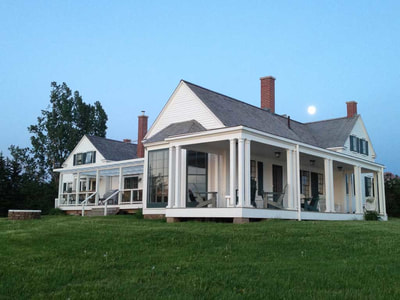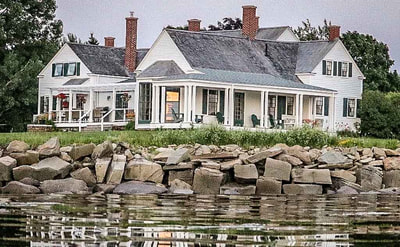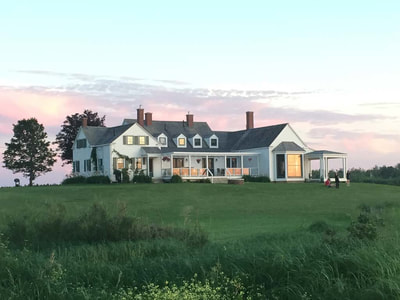An early settler of Pugwash was Jacomiah Seaman, Sr, a Loyalist emigrated from Long Island, New York, who was granted lands by the British Crown to compensate for loss of property during the American Revolution.[i] Two of his sons, Abraham (a harbormaster and tavern owner) and Stephen, likely purchased the land where Thinkers Lodge stands from three Mi’kmaqs in 1802. The original house was built around 1807.[ii] Initially, it was a 26-foot by 34-foot rectangular center hallway.
A dispute about the ownership of the land between Roach, Morse, and Seaman who was suffering from financial problems continued over eleven years until 1828, and Stephen Seaman’s family was evicted from the house in 1817. In 1818, David Sampson Pineo (1770-1838) purchased from Roach and Morse the Old Stephen Seaman House, “which was still one of two or three dwellings on the east side of Pugwash Harbour.”[iii] The purchase price for the land and house was to be paid in five annual installments of 100 pounds. David moved his wife and five children into the “harbor-front” home. These pioneers took great risks, so financial difficulties were not uncommon.[iv]
[i] Old Pugwash Families by James F. Smith, as published in The Oxford Journal, Oxford, Nova Scotia, The North Cumberland Historical Society, June 1985
[ii] The History of Pugwash by James F. Smith, the North Cumberland Historical Society, 1978, Pugwash, Nova Scotia
[iii] Old Pugwash Families by James F. Smith, NCHS, June 1985
[iv] Vivian Godfree email, April 20, 2018
After Dr. Clay’s death in 1884, his wife Mary Sophie turned Pineo Lodge over to her son Fred who sold the house to his brother, Dr. Henry Pineo Clay whose second wife Mrs. Leila Moran Clay, after his premature death in 1907, decided to live with a daughter in British Columbia. Leila sold the house through an agent to Cyrus Eaton in 1928.[ii] In 2018, descendent Melanie Clay-Smith shared how her Uncle Mike Clay, born in 1898, spent his summers at the Lodge as a child.
Cyrus also purchased for $3500 Frank Allan’s the lobster-canning factory adjacent to Pineo Lodge. Allan lived across the way on Water Street in a house that burned. Eventually, Eva Webb, Cyrus’s sister, built her home on that property. She gifted that lovely yellow home to her grandson, Paolo Brenciaglia.
Pineo Lodge had a central doorway with a gabled dormer, flanked by bay windows on each side. The original rooms were probably what is now the current gift shop, Joseph Rotblat’s room, the staircase you see upon entering the front of the house and the two bedrooms with sloping ceilings at the top of the stairs.
Around 1860, the first one and one-half story addition with dormers on the top floor was built on the east side of the house, producing an L-shaped structure. It has been suggested that the kitchen might have been a tiny house that was moved here. The other rooms included Anne Eaton’s room, the staircase and the bedroom at the top of the stairs. Around 1880, another story on the west side of the main house was added, which is now Cyrus Eaton’s room, the staircase next to it, and the bedroom above it.
When the devastating fires of 1928 and 1929 consumed much of Pugwash, Cyrus returned to help rebuild the village of his youth. He hired local residents in need of work to remove the debris of the burnt Empress Hotel, wharves, and shops on Water Street. They carted in soil and landscaped the land to create Eaton Park for the residents to enjoy all year round and to host the Canada Day celebrations. “Local people contributed what they could – cash and labour of course, one offer of 3 days of trucking and, perhaps more interesting 21 different residents volunteered a “team and driver” for a total of 124 days!” In 1929, Cyrus deeded what was formerly the Pineo property to a Nova Scotia non-profit called The Pugwash Park Commission incorporated by an act of the Legislature on April 16, 1929. Cyrus Eaton had additional plans to bring visitors to Pugwash, boost the economy and provide jobs. For example, he hoped to build a hotel near Lighthouse Point and a golf course. These goals were never accomplished.
After Cyrus acquired Pineo Lodge, he commissioned Andrew Cobb, the renowned Halifax architect, to renovate its seven bedrooms and bathrooms and to expand the Lodge. Cobb added the great room, the verandah, a living room and a library. Due to his skill, the many additions blended together to produce a coherent whole and maintain the simple elegance of the original colonial house.
The Lodge operated as a Bed and Breakfast from 1931 to 1954 and the nearby “Lobster Factory” operated as The Pagweak Tea Room. Cyrus’s sister Eva Webb, who owned a sheep farm and lived in the yellow house across the street, ran the B & B. It maintained a reputation for providing wonderful accommodations and excellent food until after the Second World War. In 1948, it cost $5 to stay in a room at Pineo Lodge, 60 cents for breakfast, 75 cents for lunch, and $1.50 for dinner at the dining hall.[iii]
The house was furnished with English and Nova Scotian antiques. Visitors frequently ask if the furniture is original. Since the lodge’s life as a B & B and later as a venue for conferences, the furnishings and hooked rugs have been replaced as needed.
In 1955, Cyrus Eaton decided to change the mission of the lodge. He envisioned establishing a sanctuary where educators, scientists, and innovative thinkers could gather, share conversations, and relax in the peaceful area adjacent to Northumberland Strait while enjoying wholesome meals. Conferences, workshops, retreats, and educational events have been held here continuously since 1955.
The most well-known conference held at the Lodge was the first Pugwash Conference on Science and World Affairs in 1957 which 22 scientists attended. They came from Canada, Communist Russia, Japan, Communist China, Poland, Germany, France, England, the United States, Hungry, and Australia. The ambiance of Thinkers Lodge, the courtesy of the staff and villagers, the graciousness of their host, Cyrus Eaton and his fiancée Anne Kinder Jones, as well as the serenity of the Northumberland Strait, contributed to the breaking down of barriers, and the creation of trust and authentic conversation. News reporters coined the phrase “Thinkers Lodge,” which is derived from Auguste Rodin’s statue called “The Thinker.”
That first conference led to a Nobel Peace Prize in 1995 shared jointly by the Pugwash Conferences on Science and World Affairs and Joseph Rotblat, its inspirational leader. Rotblat’s Nobel Peace Prize medal is displayed at Thinkers Lodge in the same room where the Lenin Peace Prize awarded to Cyrus Eaton in 1960 resides. The Canadian Federation Peace Award given in 1979 to Cyrus and his wife Anne is in Anne Eaton’s room.
Sometime after 1960, the library and secretary’s office were combined into one room, while the deck and pergola were added outside this new larger living room. Also, the double windows installed by Cobb were replaced by double French doors opening to the new deck. Originally, few windows would have looked out onto the Northumberland Strait because the harsh cold winters would have made heating difficult. If you had spent all day on the sea, the view of the sea was not as important as staying warm. According to the renovators in 2009, Andrew Cobb moved every single window to a slightly different place.
In 1996, an electrical fire ignited Thinkers Lodge. After firefighters from four towns battled the blaze, villagers formed a line from the back of the house to the Lobster Factory and passed hand-over-hand all the furniture, rugs, books, lamps, and treasures to safety. Bob Messenger, Lisa Betts, Wayne Smith, and Craig Mundle are four of the many firefighters who helped save the Lodge. A debt of gratitude is owned the firefighters and villagers, many of whom had never set foot in the Lodge.
In 2009, the three-year renovation of Thinkers Lodge began. Funding was provided through Canada’s Economic Action Plan and Parks Canada’s Cost Sharing Program which contributed towards a conservation project aimed at stabilizing the exterior of the Thinkers Lodge site. Additional funding partners grew to include Nova Scotia Department of Economics Development, Atlantic Canada Opportunities Agency, Nova Scotia Department of Tourism, Heritage and Culture, the Municipality of Cumberland Country and others. The Pugwash Park Commission and the Cumberland Regional Economic Development Association worked closely with local Cumberland and Pugwash residents to make initial restoration plans. Much of the money allocated for construction was spent in the Cumberland region.
A full-size concrete floor basement replaced the earthen, rocky shallow basement. Remedial foundation work was done. Phil McLaren was in charge of rebuilding the basement. The basement was a dirt and rock cellar that had low ceilings. Staff recalled that it was creepy to go down there. Phil’s crew dug it out by hand with shovels. They transported the dirt in buckets, then they jacked the house up and poured new concrete walls about three feet below the actual house. Stonemasons came from Spring Hill. In keeping with maintaining historical integrity, they saved the original stones, numbered each one, and then re-mortared these stones and fitted them around the exterior of the house where they originally had been.
The Lodge’s six chimneys were rebuilt from the roof up. The decks were replaced. Repairs were made to the dormer windows. The roof was replaced and re-shingled with western cedar and asphalt shingles. In 2011, Joey Gilbert worked with Rafes Construction Company from Parrsboro who were hired to replace the cedar shingles on the roof.[iv] They had to use galvanized nails and stainless-steel staples, which didn’t rust. Because the cedar gutters were rotten, they replaced them with new cedar gutters and rain downspouts: hollowed-out cedar logs. The crew painted each section of the house as they worked on it.
Inside, damaged plaster was repaired, the walls and ceilings were repainted, and the wood stripped and repainted. The tubs and sinks were enameled, and the wiring and plumbing updated. Gary Fields[v] from Apple River helped tear down plaster ceilings and replace them with dry wall in the room where the Nobel Peace resides. They crack-filled and painted the ceiling. They took down book shelves and built the shelves to hold the Nobel Peace Prize. Gary replaced the wall adjacent to the porch. Next, he helped tear out the wall near the Great Room and restudded and insulated it before replacing the window.
The restoration of Thinkers Lodge was completed in 2011 and enhanced with interpretive displays that help tell the story of how history was made here. The Lobster Factory was renovated in 2013. Fund-raising to restore the Staff House is on-going.
An interesting side note to this story is the connection of Levi Eaton, the ship builder, and Cyrus Eaton’s family to the Pineo family. Levi Eaton’s wife (Sarah Bigelow) was a sister-in-law to Mary Ann Seaman, wife of Sarah’s brother, John Bigelow Jr. Mary’s sister, Harriet Sophia Seaman, married Henry G. Pineo, whose father, David Sampson Pineo, acquired the Pineo Lodge from the Seaman family when they fell upon hard times.[vi] Three of Levi Eaton’s siblings married Bigelow children. It is apparent that via marriage, relatives of Levi Eaton and his great nephew Cyrus lived in the Pineo house that became Thinkers Lodge. However, neither Levi Eaton or Cyrus Eaton lived there as is sometimes claimed. Cyrus used to stay at the Lodge during conferences.
Currently, Thinkers Lodge is open to visitors mid-June to early September from 9:30 to 4:30 and by appointment. Conferences, workshops, and retreats are held here, bringing together educators, scientists, peace-makers, and others to share ideas and take them back to inspire their home communities. This historic site is also a lovely venue for weddings.
Please share with volunteers any stories you have about Thinkers Lodge, the Lobster Factory, the events held here, and the people who worked here. Please share with us any additional information or corrections you have about Thinkers Lodge and this historic site.
[i] ibid.
[ii] Old Pugwash Families by James F. Smith, NCHS, June 1985
[iii] Original bill at Pineo Lodge, MSS 3913 Cyrus S Eaton Papers, Western Reserve Historical Society, Cleveland, Ohio
[iv] Joey Gilbert Interview by Cathy Eaton, Summer 2015
[v] Gary Fields Interview by Cathy Eaton, Summer 2015
[vi] The History of Pugwash by James Smith, the North Cumberland Historical Society, Pugwash, Nova Scotia, 1978
Thinkers Lodge, 1957 Tall Ship Passing Thinkers Lodge, 2017
Canada’s 150th Birthday



 RSS Feed
RSS Feed